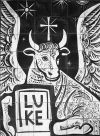
The Gospel of Luke
THE WORD OF GOD: Luke 8,1-21
The Frame: 8,1-3 and 8,19-21
Reading the whole unit, 8,1-21, we find that the key words are "hear" (8,8.10.12.13.14.15.18.21) and "word" (8,11.13.15.21). When we read the parable, we will see how Luke has changed Mark to emphasise these two words.
When Jesus preached the kingdom of God in 4,43-44 he was still on his own without disciples. Now in 8,1-3 he has a community gathered round him.
As might be expected, this community includes in 8,1 the Twelve (6,13); they are not yet called apostles.
What is then unexpected and yet so characteristic of Jesus in this Gospel is the inclusion of a group of women. Joanna at least has a respectable social status. These women will reappear as witnesses to the death (23,55) and resurrection (24,10) of Jesus. They are also part of the early community (Acts 1,13-14). Indeed, as someone once pointed out, they were well qualified to be the replacement apostle (Acts 1,22).
Luke says the women had been cured of evil spirits and infirmities and in particular Mary Magdalene had had seven demons cast out (8,2). Seven is the number of completeness or wholeness: Mary must have been a very sick woman cured by Jesus. There is nothing here to suggest sin or prostitution whatever Western Christian tradition may say about her (as we noted in the previous chapter). The healing of Peter's mother in law (4,39), with Jesus rebuking the fever, is another healing presented as an exorcism.
The role of the women given in 8,3 is to serve, though that will be obscured by the translations. We see this also for Peter's mother law (4,39) and with Martha (10,40). It is also a more general Christian role, for example the Seven in Acts (Acts 6,2).
Acts 6,2 is a useful starting point for reflecting on the other half of the frame (8,19-21) because there is a stress there on the word of God as well as serving at tables. The community of 8,1-3 become the true family of God when they hear and act on the Word of God. The episode of the two sisters Martha and Mary will make this clear (10,38-42). This of course does not exclude Mary the mother of Jesus (2,19).
The frame is therefore giving us an anticipation of the portrait of the ideal Christian community provided in the Acts of the Apostles (Acts 2,42-47).
Let us now return to the main page to look at what comes between the frame, that is, the parable of the sower.
The Parable of the Sower: Lk 8,4-18
The parable of the sower is told by Matthew (Mt 13,1-23) as well as Mark (Mk 4,1-20) but we will as usual make our comparison mainly with Mark. In both Mark and Matthew though, the orginal parable is more about the kingdom while the interpretation in those Gospels is best seen as a later understanding of the parable which stresses the word.
The changes Luke makes to the story of the sower are mostly stylistic. One or two are significant especially as we know where Luke is going with the story, that he will want to stress the word. Notably, the sower went out to sow HIS seed (8,5). The thorns (8,7) grew up WITH the seed and so choked it. And the fruit is now simply a hundredfold (8,8).
Jesus' explanation of the purpose of parables is kept to a brief quotation from Isaiah, similar to Mark though omitting the note of rejection (Mk 4,12). Matthew does give the quotation in full (Mt 13,14-15) but Luke does not use the full quotation until the very end of his story (Acts 28,25-28). These words from chapter 6 of Isaiah are quoted by all the Gospels. Clearly they were important to the early Christians as they tried to understand why the Jews did not accept Jesus.
The explanation of the parable of the sower (8,11-14) is now clearly about the word: Luke says that the seed is the word of God (8,11). The devil is mentioned, he is never far away in this Gospel. It is the devil (8,12) who takes away the word from their hearts "that they many not believe and be saved". "Saved" and its related words are an important Lucan theme (1,47; 7,50; 8,36, for example).
Luke speaks of the time of trial or temptation (8,13) rather than persecution (Mk 4,17). He also makes a special mention of the pleasures of this life which fail to bring mature fruit (8,14). All of this builds up a picture of living by the word of God, less sucessfully or more sucessfully, with a generous and good heart and with patience (8,15).
The sayings which follow (8,16-18) are given a special focus by the comment added by Luke "that those who enter may see the light" (8,16). We can see these sayings as a picture of the Church as a household, the place where God's word is to be heard. The light of the Church is open to all, unlike the mystery religions of the time where the full message was open only to initiates.
Back now to the main page so that we can move on to read more of this chapter.